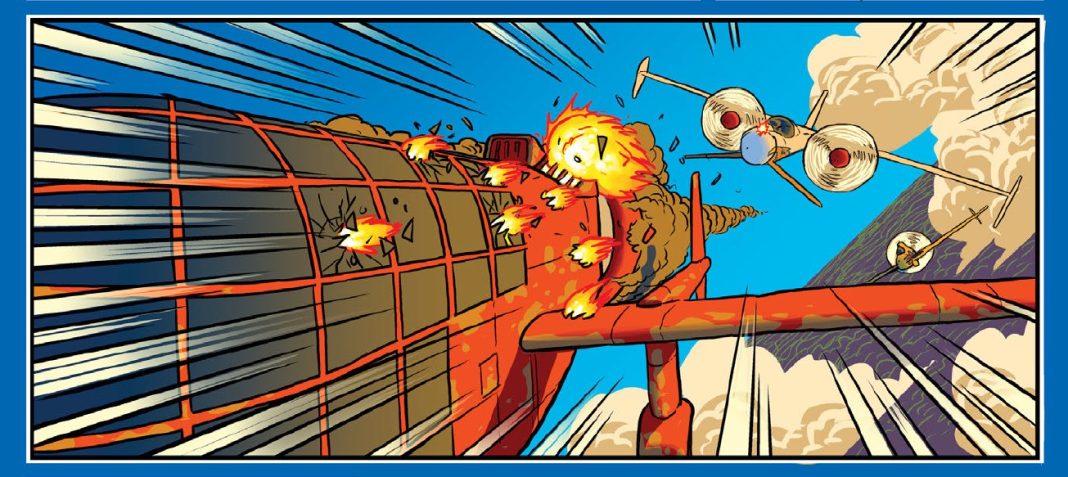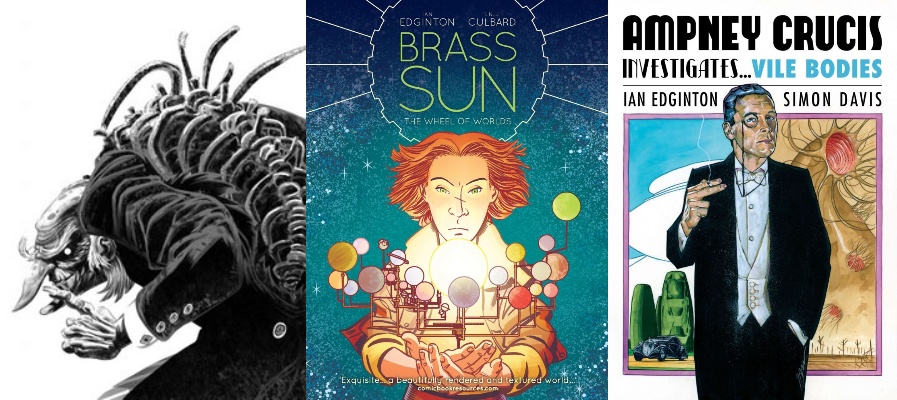This Wednesday brings a special issue of 2000 AD: a complete slate of new series begin their run in the weekly anthology. A perfect jumping on point for new readers. But Prog 2351 promises to be even more special – aside from a Judge Dredd/Sam Slade faceoff – because it marks the long awaited return of writer Ian Edginton and artist D’Israeli‘s airpunk series Helium. Eight years(!) since the shock ending of Helium‘s debut run in Progs 1934-1945, the wait is finally over.
The Beat’s resident Squaxx dek Thargo Dean Simons chats with the pair to find out about the making of the series, its long absence, and their decades-strong creative partnership.
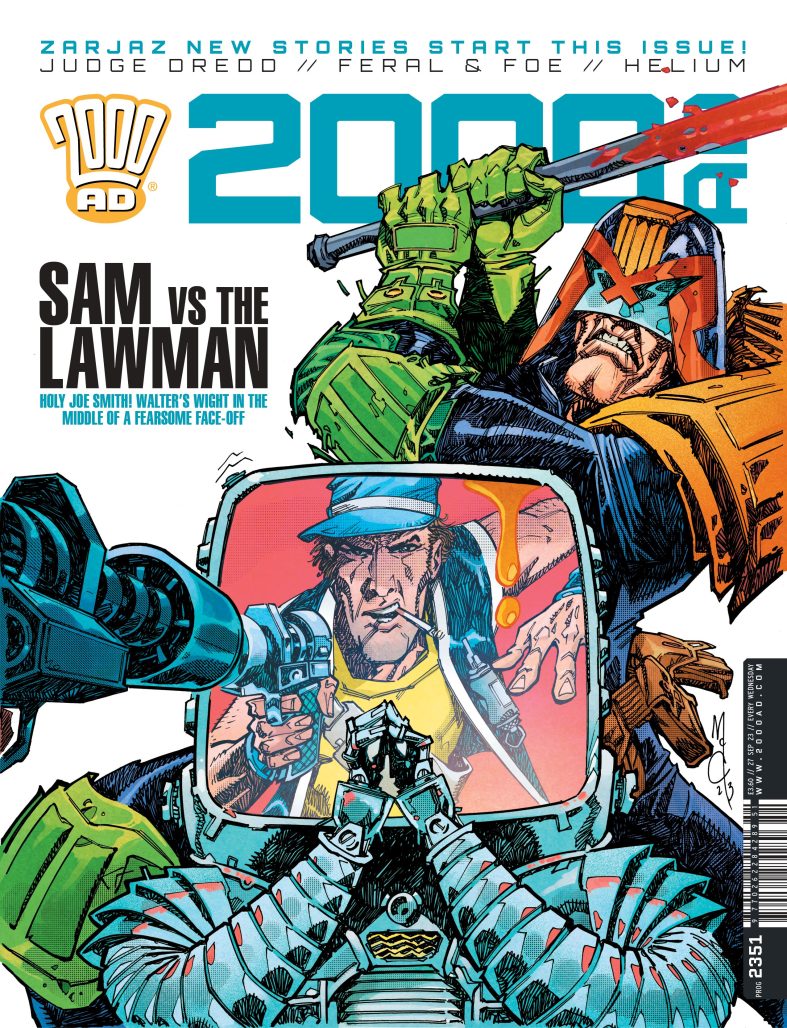
DEAN SIMONS: At the conclusion of the first series, there was a lot going on! Do we pick up immediately after this or do we get a significant time jump? Will it be accessible to new readers who missed the first series?
IAN EDGINTON: Yep, we jump straight back into it. There is some recapping along the way but Rebellion have very generously included a code with the jumping on issue (Prog 2351) that lets you download the entire first series for free!
DS: Helium’s setting is quite different – largely above the cloudline, neither in space nor fully on terra firma – where did the idea, its characters and setting come from? Many inspirations to mention?
IE: I’d always wanted to do a story that had airships and aircraft front and centre, the more eccentric and Heath Robinson looking the better! The question was why are they there? Why would there be a need for such things? Out of this sprang the idea for Helium.
I posited that World War One went on for decades, centuries even. Biological and chemical weapons poisoned the Earth and covered it in the Poison Belt, a miles deep toxic miasma that covers the majority of the Earth’s surface. Only those living on the high ground survived. Eventually the war fizzled out but you had these pockets of civilisation thriving on mountain tops etc, and the principle modes of transport would be, of course… airships and aircraft!
There’s trade between some of the cities and conflict between others and then thrown in the mix is the revelation that there’s life existing below the Poison Belt. There are people living in glass domed cities and also toxin breathing mutants. Against this backdrop we find Foundling Hodge, who was found as a baby, beached on one of the mountain top redoubts. She was raised by the local police constable and his wife but we discover that she hails from one of the cities below the Poison Belt and that there is much more to her than meets the eye!
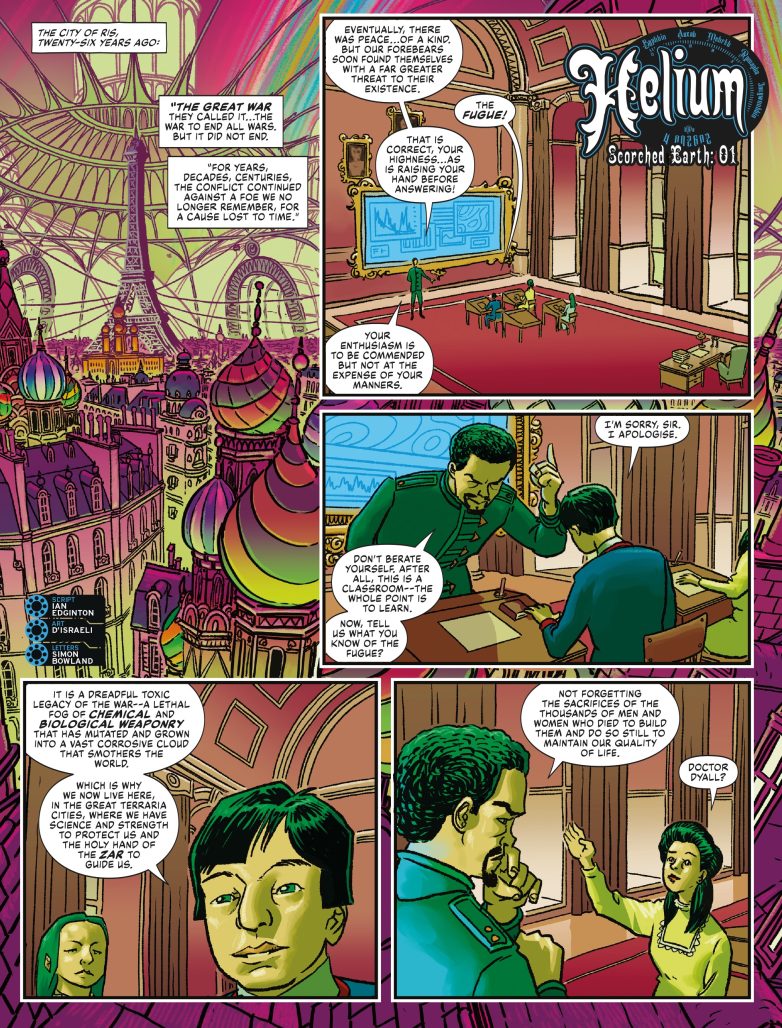
DS: D’Israeli, considering you work on a number of different series – not least Scarlet Traces and Stickleback – how did you go about making Helium and its world feel visually distinctive? Is it a difficult process trying to make a new work stand out from other strips in the prog AND from your own work as well? It sounds daunting.
D’ISRAELI: As an artist, what you’re selling is your own unique take on things, so after thirty-odd years of drawing comics, I’m confident enough in my own skin that I think much more about the best way of expressing the story than differentiating myself from other 2000AD creators. That said, keeping my work fresh, so I’m not just repeating myself, is an ongoing struggle, and one that I find harder with colour than black & white.
With Scarlet Traces, I’ve been trying to match the art style to the era the stories are set in, so the first couple of 2000AD series were inspired by the painted style of Frank Hampson’s work on Dan Dare and Don Lawrence‘s work on The Trigan Empire – perfect for the planetary romance elements of the Venus-based series. For the later, Earth-based series, I adopted a “colour chiaroscuro” technique developed by John M Burns and Gerry Haylock for Countdown comic in the very early 70’s.
By the time I got to the new series of Helium I was in the mood for something different, and looking back to the first series of Helium I realised I’d been using a more simplified approach that seemed stronger to me than the rather faffy habits I’d been getting into at the end of Scarlet Traces. In the end, going back to that simpler approach felt like a positive move forward. A lot of series two is set under the Fugue, in exotic luminous coral-like environments, so in a lot of ways keeping it simple and letting the content do the talking was the best policy.
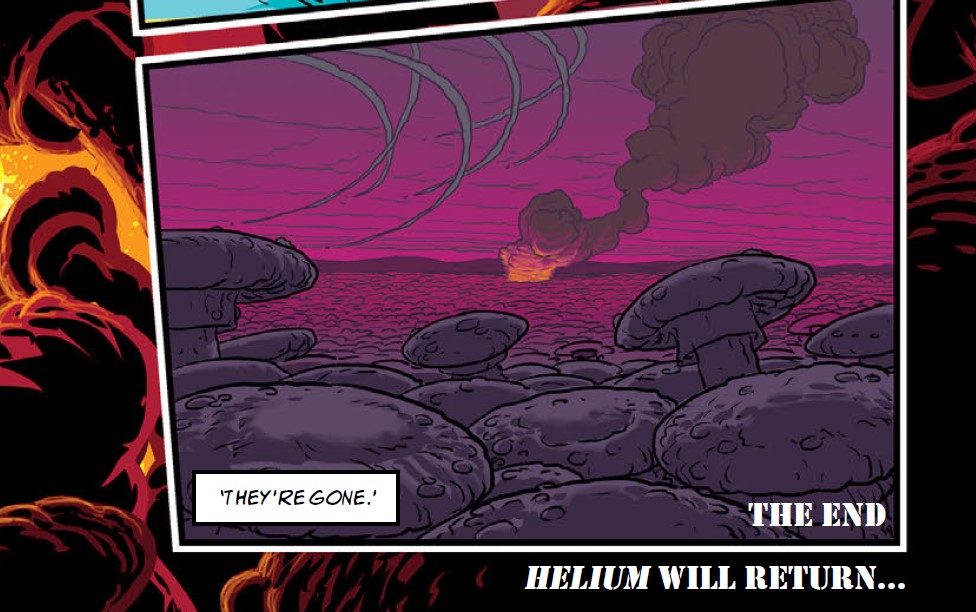
DS: Helium has been away for quite some time – the last series was all the way back in 2015 – was there a reason for the gap?
D’I: We’d planned Helium as a sort of “Scarlet Traces for 2000AD” at a time when we still owned Scarlet Traces and it was at Dark Horse. When our contract with Dark Horse lapsed in mid-2015, and Rebellion offered to buy Scarlet Traces, we suddenly had new series of Scarlet Traces to produce for 2000AD, so Helium drifted to the side. We assumed it would be completely forgotten, so we’ve been incredibly gratified at the positive reception we’ve had to the news that it’s coming back.
IE: It’s been a while hasn’t it! I think it’s mainly due to life and other stuff getting in the way. Matt [Brooker, aka D’Israeli] and I did other series for 2000AD both together and with others. He then did Witchfinder, a Hellboy universe series for Dark Horse, and I was busy writing several series for Iron Maiden and KISS amongst many others.
DS: Has much changed in the story’s development in the interim or are you following the original outline for series two that you had at the time?
IE: Not on the whole, no. Going back to the original outline after such a long break, I did think I might want to redo some of it – but I was still happy with it overall. There were a few small tweaks but nothing major.
DS: Ian, the use of language and class is an interesting feature in your stories. Many of your heroes and leads use a colloquial working class English not far off cockney. Is that deliberate across your work? Where do you draw it from?
IE: It’s meant to be a kind of hybrid language that’s evolved from those who initially sought shelter on the high ground and the eventual civilisations that developed there. The bulk of the first series is set in what’s left of the UK, so the language is a blend of a number of different working class accents of the time. The language evolved over decades, incorporating many different dialect and accents into one native speech pattern.
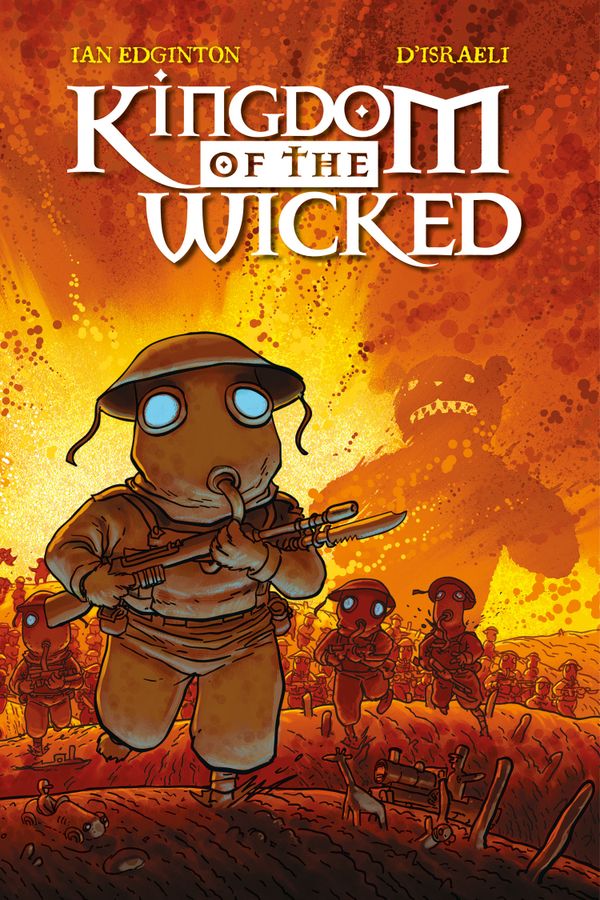
DS: The Edginton and D’Israeli partnership is quite a long one – I believe you both entered comics together and you very frequently collaborate. How did you meet, how do you keep the creative relationship fresh, and how much of the partnership helps build new ideas and avenues for story?
IE: We met over thirty-five years ago now. There was a comic magazine called Heartbreak Hotel run by Don Melia and Lionel Gracey-Whitman. I pitched them a short story called ‘God’s Little Acre’ and they paired me with Matt on the art chores. Sadly Heartbreak Hotel folded before the story could run, but it did get picked up for the second issue of Fleetway’s Revolver [1990-1991 British anthology]. We enjoyed working together and so decided to collaborate on a mini series I’d written called Kingdom of the Wicked. This was going to be published by Tundra UK who, alas, also folded before it could happen. It was later picked up by Caliber Comics in the US but only printed in black and white. There was a lovely full colour hardcover published by Titan several years later though.
Matt and I like working together because we share a similar kind of mentality and mind set. We’re both around the same age, read and watched a lot of the same stuff, were only-children raised by our mums. There’s a sense of nostalgia, dry humour, warmth and Britishness to what we do. I don’t mean tub thumping nationalism, but something more kind, civil and understated.
A while ago our work was termed ‘Pipe and Slippers Gothic’ and I think that still stands. We’ll talk frequently and I’ll run ideas by Matt to see which ones he likes and would enjoy working on. It has to be fun for both of us to do otherwise it’s not worth doing.
We’ve got something brewing at the moment that’s set in 1950’s LA which we can’t wait to get started on!
D’I: From my perspective, Ian’s a powerhouse in terms of spotting simple-but-strong ideas to use as the basis for new series. I’m quite good at suggesting refinements to those ideas, so we’ll often have a phone call where we bash an idea back-and-forth, then I’ll go off and generate some character sketches and other designs.
We’ve worked together so long that we’ve got strong mutual trust, so once we get into production I know I can leave Ian to give me great scripts and he trusts me to interpret them in my own style. Very occasionally he’ll ring me to run an idea by me, or I’ll email him a panel to check I’ve understood what’s needed, but generally we leave each other to get on with it.
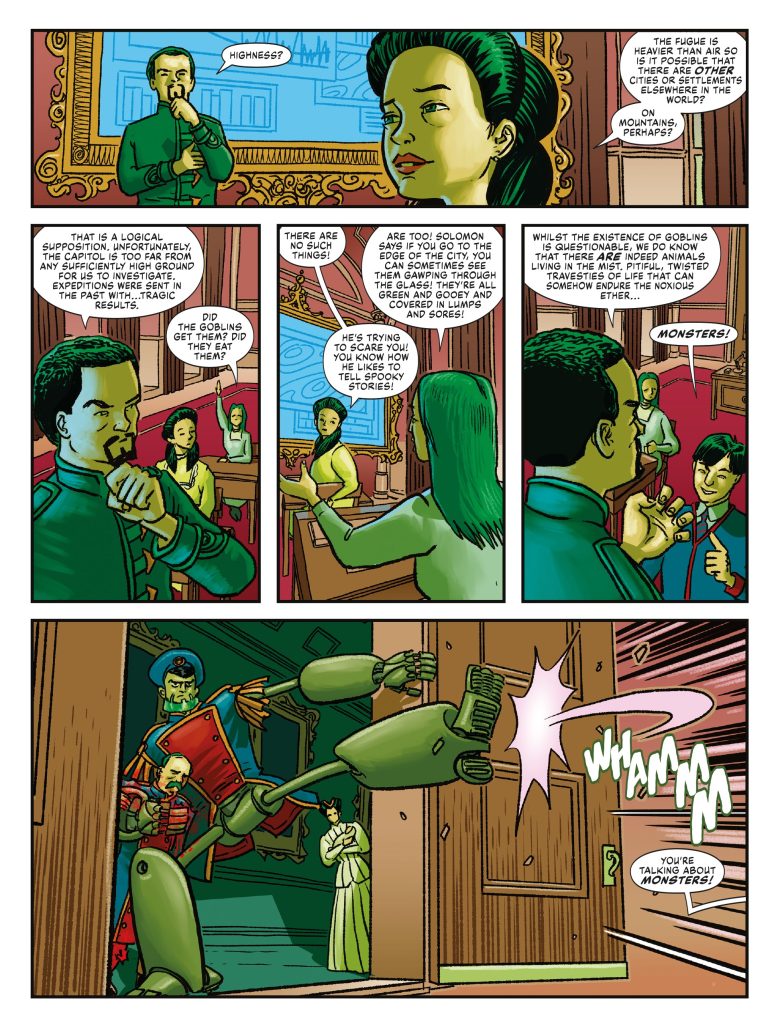
DS: What keeps you both working on 2000AD instead of at another publisher in the UK or US? Especially when it comes to creating new strips?
IE: I like working for 2000AD because they’re open to publishing a diverse range of stories. I’ve written steampunk yarns, science fiction, fantasy, horror, pirates, vampires, you name it. You can admittedly do the same with a US publisher but it takes a lot longer to grind through the approval process and to getting the book on the shelves.
Tharg [aka Matt Smith] is an editor of few words but his feedback is always on point. If he doesn’t think a pitch will fly he’ll tell you straight out – but likewise if he thinks it has legs then he’ll give you notes where it needs fixing and get you to resubmit. If he likes something outright you’ll get an “All good.” and off you go!
D’I: The thing I love about 2000AD is you’ve really only got one layer of management, so Tharg-in-residence Matt Smith can give you a yes or no on a project straight away, without having to refer to however many layers of management above him. Also, once we get a project under way, I can trust Matt to catch me if I get sloppy, but he’s not constantly digging his fingers into the process like some other publishers I won’t name coughcough*
DS: Ian, since Helium is returning, I was wondering about the status of your other series – will Stickleback, Ampney Crucis and Brass Sun be returning to the prog anytime soon?
IE: After Helium, Matt and I will be working on a Scarlet Traces prequel and then the LA story if it gets approved! We do have designs on more Stickleback at some point. Ampney Crucis or a variation thereof will be cropping up so keep your eyes peeled!
I keep on meaning to get back to Brass Sun. I have it all laid out right to the very end. I just need to sit my arse in the chair and get on with it!
2000 AD Prog 2351 releases Wednesday (September 27) in UK newsagents and comic shops; physically and digitally from the 2000 AD webshop; and can be ordered via Diamond (Previews Code JUL231919, on sale date November 1).


